Physical Address
304 North Cardinal St.
Dorchester Center, MA 02124
Physical Address
304 North Cardinal St.
Dorchester Center, MA 02124
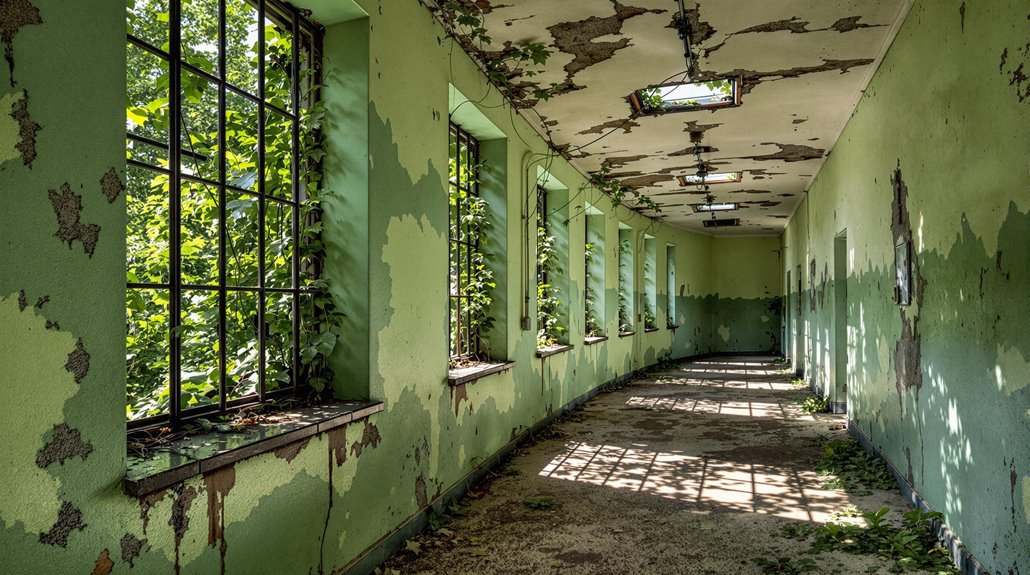
Once a grand hospital turned Nazi sanctuary, Beelitz-Heilstätten's haunting ruins near Berlin beckon urban explorers into its mysterious past.
You will discover Beelitz-Heilstätten's crumbling pavilions just 30 miles southwest of Berlin, where nearly a century of history lies frozen in time. This sprawling medical complex once served as a tuberculosis sanctuary, a Nazi military hospital, and a Soviet command post before nature began reclaiming its halls. Today, you can explore its haunting Art Deco architecture, climb the treetop walkway, or join specialized photography tours – but first, you will need to know how to navigate this fascinating piece of German history.
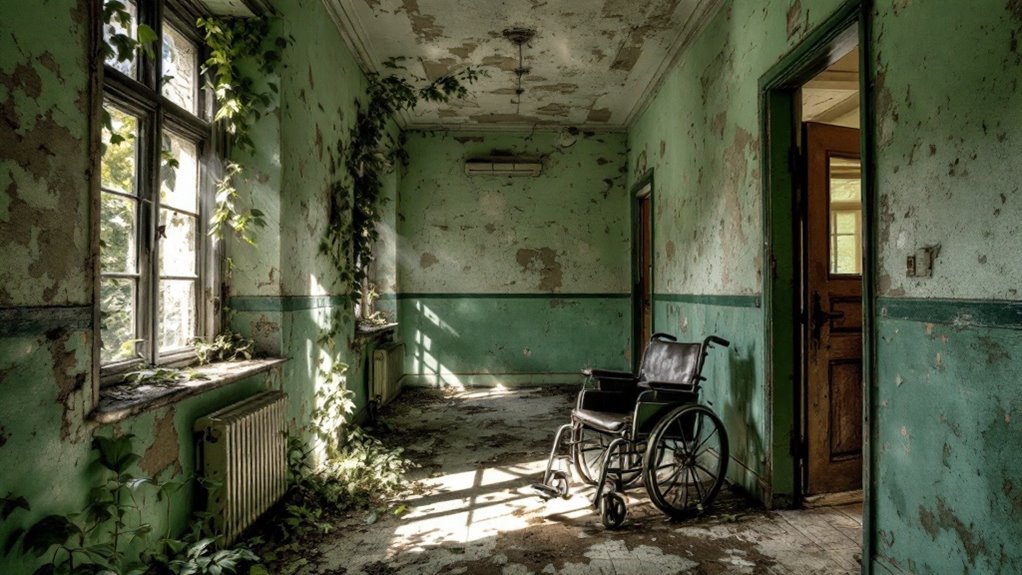
While Beelitz-Heilstätten began as a tuberculosis treatment center in 1898, the sprawling 200-hectare complex would witness some of Germany's darkest moments throughout the 20th century.
The facility's history took a grim turn during World War I when it served as a military hospital, treating over 18,000 soldiers – including a young Adolf Hitler. The massive complex consists of around 60 buildings scattered throughout the grounds.
After World War II, the Soviets seized control, transforming it into their largest military hospital outside the USSR. In 1990, East German leader Erich Honecker sought refuge here before fleeing to Moscow.
From treating tuberculosis patients to sheltering Communist leaders, Beelitz-Heilstätten stood as a silent witness to Germany's turbulent post-war transformation.
The site's most sinister chapter came in 1989-1990, when serial killer Wolfgang Schmidt terrorized the area, murdering six people near the complex.
Today, bullet marks from the 1945 battles between Nazi and Soviet forces remain visible on the deteriorating walls.
Today, visiting these haunting grounds requires careful planning, but reaching Beelitz-Heilstätten from Berlin offers several straightforward options.
If you're driving, take the A9 motorway southwest and exit at "Beelitz-Heilstätten," following signs to the "Baumkronenpfad" parking area.
By public transport, catch the RB33 regional train from Berlin Hauptbahnhof to Beelitz-Heilstätten station – a 40-minute journey followed by a short forest walk to the entrance. Alternatively, trains run hourly from Berlin-Wannsee station.
You'll need to arrive at least an hour before closing time, as the ticket office shuts early. Entry costs 9.50 EUR, with guided tours around 10 EUR extra.
While some areas remain restricted, the treetop walkway offers wheelchair accessibility through a ramp system, though the grounds feature uneven terrain requiring sturdy footwear. The expansive 140 hectares of woodland and parkland make it advisable to plan your route in advance.
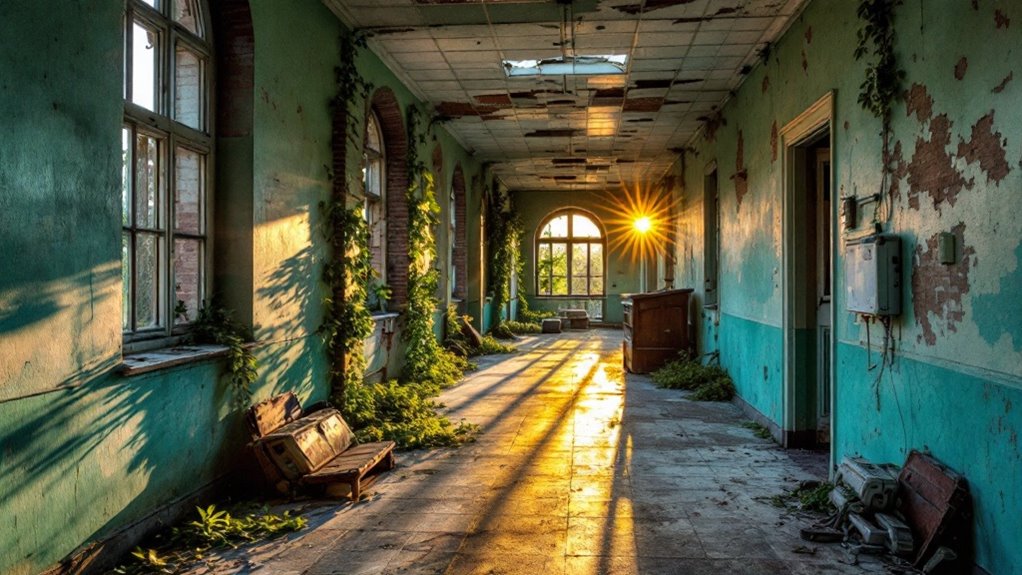
Whether you're an urban explorer or photography enthusiast, timing your visit to Beelitz-Heilstätten can dramatically impact your experience and image quality.
Visit during peak season (April-October) for full access to the treetop trail and interior tours, or opt for shoulder seasons to avoid crowds. During your exploration, you'll discover fascinating Soviet-era Cyrillic inscriptions throughout the complex, adding historical depth to your photographs.
Bring essential gear including a wide-angle lens for expansive corridors, a tripod for low-light shots, and a powerful flashlight to illuminate dark corners.
You'll get the best exterior photos during golden hour, when long shadows emphasize the building's architectural details. For interior shots, use fast prime lenses and HDR techniques to balance challenging lighting conditions.
Don't forget safety requirements: wear a helmet and closed-toe shoes, and always stick to guided tours.
The site closes during severe weather, so check conditions before your visit.
As you plan your visit to Beelitz-Heilstätten, several guided tour options cater to different interests and budgets. The basic "Zeitenwandel – Wandelzeiten" tour costs €6 per person and provides a one-hour historical overview.
For more specialized experiences, you'll discover public guided tours ranging from €10-15 through third-party operators.
If you're interested in specific areas, the "Old Surgery Building Tour" accommodates groups up to 30 people for €250, while weekend tours of dining halls and bathhouses cost €10 per person. The site features 40-meter observation tower offering panoramic views of the entire complex.
Photography enthusiasts can book special access tours starting at €10 through Go2Know. For international visitors, private tours are available in English, Russian, French, and Italian with advance booking.
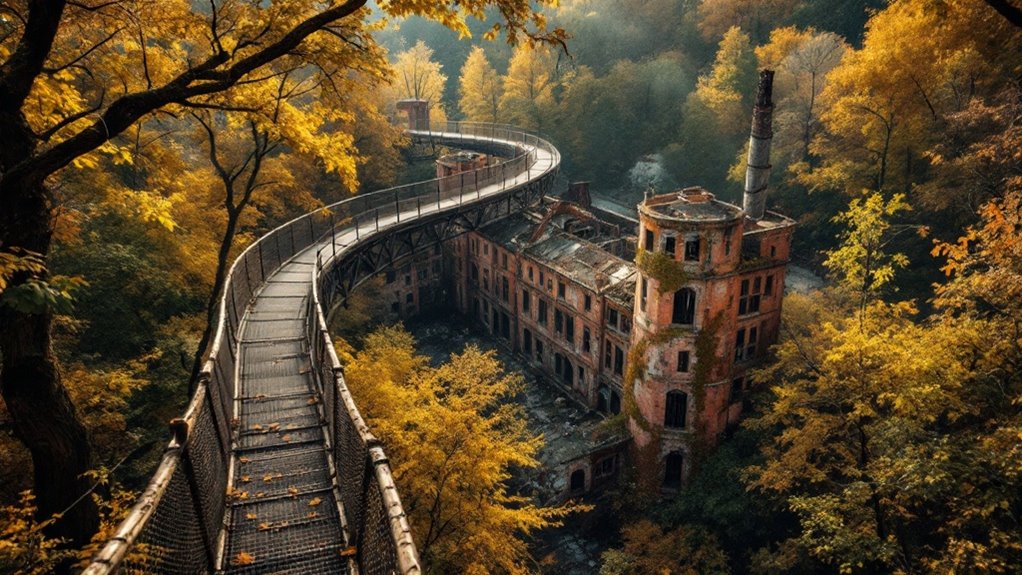
The Beelitz-Heilstätten Treetop Walkway offers visitors a unique perspective of this historic medical complex from above.
You'll traverse a steel-and-wood pathway stretching 700-800 meters at heights of 17-23 meters, with a clear view of the ruins below, including the war-damaged Pavilion B IV.
As you walk the 2.2-meter-wide path, you'll encounter information panels detailing the site's history as a tuberculosis treatment center and Soviet military hospital.
For the best views, climb the 40.5-meter viewing tower, where you can use telescopes to spot Berlin on clear days. The tower, constructed with 700 tons of concrete, features five accessible levels including a viewing platform at 36 meters.
Located just 45 minutes away from central Berlin, this fascinating site makes for an ideal day trip destination.
The walkway's fully wheelchair accessible, and there's an emergency staircase midway for safety.
You'll see over 65 species of trees and shrubs that have reclaimed the grounds since the Soviets departed in 1994.
Inside this sprawling medical complex, you'll discover architectural marvels spanning over a century of history. The 44-meter water tower stands as the site's crowning achievement, featuring restored brickwork and an adjacent coal-fired power plant from the turn of the 20th century.
Gender-segregated pavilions showcase distinct architectural styles, while the Art Deco surgical ward offers glimpses into early medical innovations. The facility was designed with fresh forest air in mind, chosen specifically for its location in Beelitz's wooded area.
Key highlights you won't want to miss:
Don't overlook the hidden underground bunker network or the ceramic-fitted inhalation therapy rooms that tell the story of pioneering tuberculosis treatments.
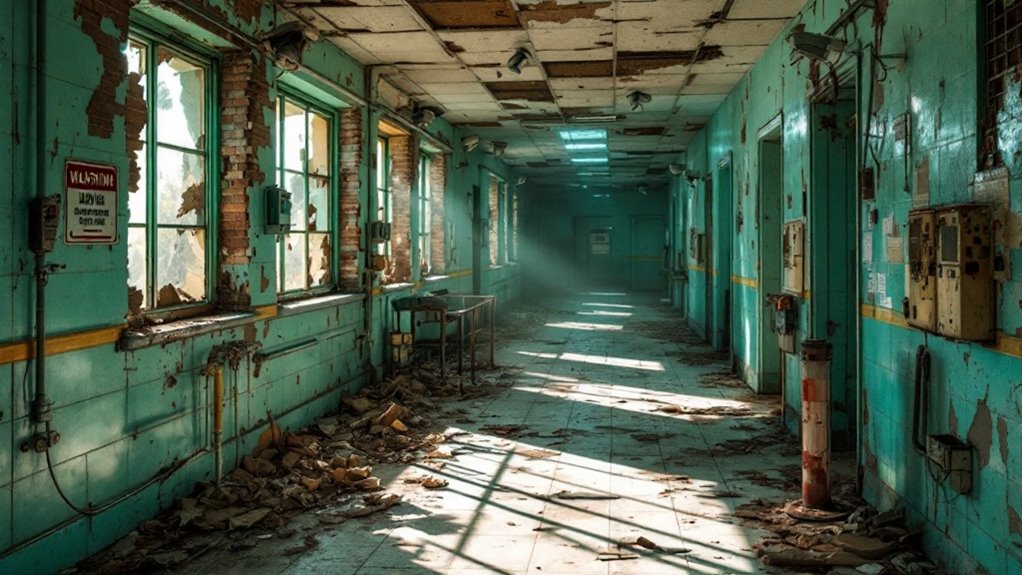
While these historic buildings hold fascinating architectural treasures, exploring Beelitz-Heilstätten comes with strict safety protocols you'll need to follow.
Venture through history and architectural beauty at Beelitz-Heilstätten, where safety measures protect both visitors and these remarkable structures.
You must join guided tours for interior access, with group sizes limited to 15-30 people depending on the route. You'll need to sign liability waivers and wear helmets during indoor explorations due to structural hazards like unstable floors and exposed rebar.
If you're interested in non-German language tours, book in advance. The site enforces age restrictions – you must be at least 7 years old for basic tours and 12-16+ for advanced routes.
The modern Tree Top Walk provides a safer way to view the historic structures from above while maintaining distance from potentially dangerous areas.
Be aware that weather affects access: winter hours run 10am-4pm on weekends only, and elevated pathways close during severe weather.
Don't forget that commercial photography requires permits, and night exploration isn't allowed without special authorization.
Three core principles guided Beelitz-Heilstätten's revolutionary design: healing through nature, spiritual wellness, and medical innovation.
The architects Schmieden and Boethke created a self-contained medical city with ingenious features that you'll discover throughout the complex. During its first 25 years, the facility provided treatment to over 110,000 patients.
Key architectural elements you'll encounter include:
You'll notice how the buildings harmonize with the 200-acre forest park, featuring strategic east-west orientations that maximize sunlight exposure.
The sophisticated ventilation systems channel forest air directly into the buildings, while geometric tile patterns and carved wooden details showcase the era's exceptional craftsmanship.
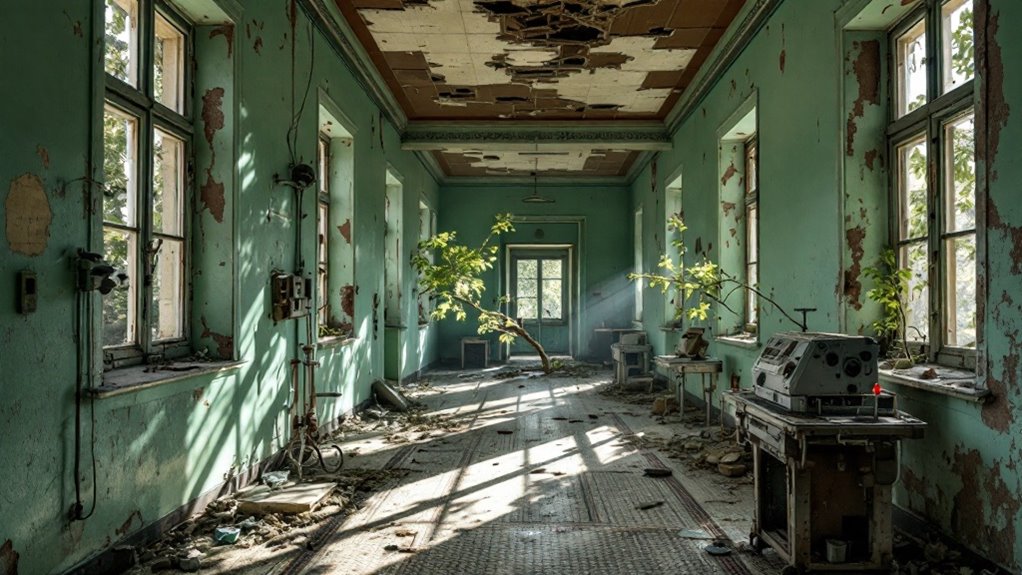
Beelitz-Heilstätten's haunting architecture and dramatic history have made it a coveted filming location for major productions. You'll recognize its eerie corridors from Roman Polanski's "The Pianist" (2002) and Tom Cruise's "Valkyrie" (2008).
Located in historic Brandenburg, the facility is just one of many fascinating landmarks that make Berlin worth exploring. More recently, the site starred in Netflix's "1899" series and the psychological horror film "A Cure for Wellness" (2016). Originally constructed to treat patients with lung diseases, the facility took advantage of the pristine air quality in the surrounding nature park.
The complex's cultural significance extends beyond film. Notable patients included Adolf Hitler, who recovered here in 1916 after his Somme injuries, and GDR leader Erich Honecker.
Since the Soviet withdrawal in 1995, it's become a magnet for urban explorers and photographers. While guided tours now manage visitor access, about half the complex remains restricted.
The "Baumkronenpfad" treetop walk offers a safer way to experience this historic site.
You will discover Beelitz-Heilstätten offers a perfect blend of history, architecture, and atmospheric exploration. Whether you're taking guided tours through the surgical ward or walking the treetop pathway, you're experiencing a unique slice of German history. Remember to book your visit in advance, follow all safety guidelines, and bring your camera to capture the haunting beauty of this remarkable site. Don't miss the iconic water tower and Art Deco details.